
|   |

|   |
 e-mail: ukb7@rediffmail.com Other theatres - symbolic, magic November 6, 2019 In the ancient Greek drama as well as in the great Shakespearean theatre it inspired, usually a single transition takes place in the performance that is crucial for you as the viewer: transition from "Here and Now" of your mundane present to the "There and Then" of the dramatic events. The theatre is palpable behind the "invisible fourth wall"; the flesh-and-blood actors deliver their dialogue; there is a reasonable unity of time and space; and the sequence of events takes you from the formulation of a problem right up to its solution. But there can also be an alternative theatre of the kind conceived by Sergei Obraztsov of Russia, for instance, which may permit multiple transitions from the "Here and Now" to the "There and Then". In their world that calls -from the beginning -- for suspension of your disbelief, symbols and allegories are galore; the actors can be physical characters and/or puppets who speak the puppeteer's lingo and performing dolls; the unity of time and space goes for a toss; and the sequence of events can be equally topsy-turvy. Two excellent specimens of the latter variety were witnessed recently by this critic. Bir Purush (The Brave-heart) Photos courtesy: Shilpisangha Presented on October 23 by 'Shilpisangha' with child actors all this side of 18 years, the play was crafted around Tagore's eponymous poem that has the veneer of a boy's fantasy and is built around the core of his abiding love for mother. The child has an imaginary encounter with the blood and gore of dacoity, when his mother had undertaken a perilous journey in a palanquin and the boy, on horseback, had acted out as her bodyguard. Lost in a no-man's land, they are attacked by ferocious men with swords and shields, and are saved only by the boy's fierce fight, vanquishing all the marauders. The tired, yet jubilant boy, taken for dead by everybody, returns -- hold your breath! - to his mother's lap for receiving accolade. 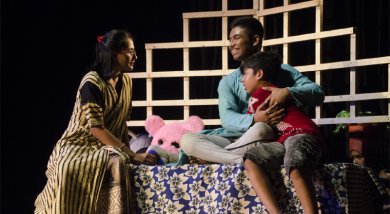
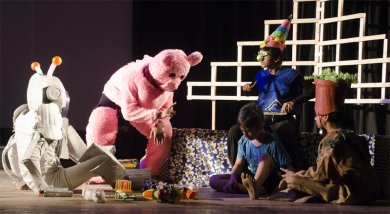
Scripted imaginatively by Rajarshi Dhara and Swapnajoy Ganguly, and wonderfully directed by Kingshuk Bandyopadhyay, the phantasmagoria is around the utterly patriotic father, Major Abhisek Roy (Shataditya Paul, aged 17 plus) of the Indian army posted out on a distant border; the lonely child Tatai (Debajyoti Ganguly, 14 plus); and the frustrated mother Paulami (Prajacta Pal, 15 plus). Tatai - enacted with great aplomb -- spends his spare time playing with "speaking" dolls like the teddy bear, the band-drummer, the astronaut, et al. Tatai dreams out Tagore's fantasy-verse where he is the victorious warrior saving his mother's honor. "The play within a play" is very well paced out, replicating his father's real-life patriotism for motherland. A sudden grant of leave brings the family blissfully together and the father-son duo has a great time. Equally suddenly, cancellation of leave gets the Major rushing back to a patriot's duty, only to get killed by enemy fire. 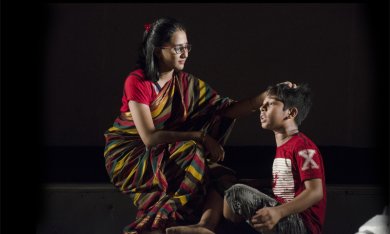
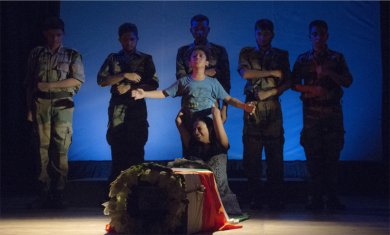
Thereafter, the play scales a rare dramatic height. The soldiers carry the martyr's coffin home in a perfect show of martial respect, allow the devastated family bid final farewell, fold the national flag with great dignity and hand it over to the boy, informing him that his father has become a "brave-heart" , -- only to wrench the boy's anguished cry: " I want to be a brave-heart, too…". It is a very moving experience. Paths of Truth Photos courtesy: Dolls Theatre Presented on the same evening by Dolls Theatre, this was a puppet theatre based on the real-life incidents of Champaran peasant movement in Bihar in April 1917. Launched by Gandhiji, the movement had many historical firsts to its credit. It was where he honed his twin weapons used later in India's freedom struggle: Ahimsa (non-violence) and Satyagraha (zeal for truth). On the personal front, it gave Gandhiji two firsts as well: the donning of common man's loin-cloth after discarding the Western attire for good and the favorite sobriquet Bapu (father) earned by him from the masses for life. 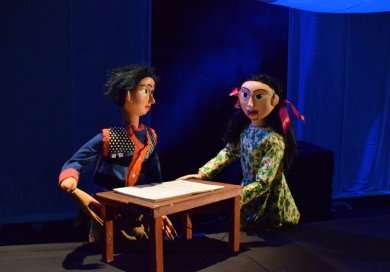
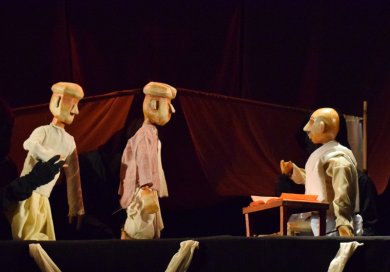
Conceived and very ably directed by Sudip Gupta, the recent Sangeet Natak Akademi awardee, the story was told as a dramatic narrative. It began with Gandhiji, recently returned from South Africa's racial upheaval, being accosted by two peasant leaders from Champaran who requested him to lead the peasant unrest there. In Champaran, there were the greedy British merchants of East India Company on one side, forcing the rural peasantry to undertake cultivation of the completely uneconomic Neel (vegetable dye of indigo) as an obligatory part of their total land produce, but fetching the merchants high price in the Western and Chinese markets. On the other side was the hapless band of reluctant and impoverished peasants, for whom cultivating the new water-hungry vegetation would leave their land totally infertile and make them doomed. How Gandhiji travelled from village to village to organize his non-cooperation movement, how he fought many court battles against the merchants using torture, humiliation of women and brute force for extraction of the lucrative cash-crop, and eventually, how the administration recapitulated to withdraw all the harsh measures perpetuated by the English merchant class, was the rest of the story. The historical authenticity was kept intact, in an otherwise completely allegorical narrative by the medley of different puppet characters manipulated by human puppeteers - blended with the black-robed Bunraku actors - and a human actor as the announcer of official notices. The action took place simultaneously with shadow puppets at the backdrop; the rod puppets and the Japanese-styled Bunraku players (meant to be invisible to the viewer) using the mid stage; and the human herald strutting on the front stage. It achieved a mix of great imagination, and built the magic of puppetry providing an alternative narrative. 

The play was a fitting tribute for the 150th birth anniversary of the great Indian savant whose two messages -- that you can fight the utmost evil with the courage of your conviction for non-violence and truth; and that sticking to the path of righteousness would ultimately cower the ugliest villain -- were carried home with a telling effect.  Dr. Utpal K Banerjee is a scholar-commentator on performing arts over last four decades. He has authored 23 books on Indian art and culture, and 10 on Tagore studies. He served IGNCA as National Project Director, was a Tagore Research Scholar and is recipient of Padma Shri. Post your comments Please provide your name and email id when you use the Anonymous profile in the blog to post a comment. All appropriate comments posted with name and email id in the blog will also be featured in the site. |